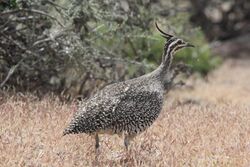Biology:Eudromia
| Eudromia | |
|---|---|

| |
| Elegant crested tinamou (Eudromia elegans) | |
| Scientific classification | |
| Domain: | Eukaryota |
| Kingdom: | Animalia |
| Phylum: | Chordata |
| Class: | Aves |
| Infraclass: | Palaeognathae |
| Order: | Tinamiformes |
| Family: | Tinamidae |
| Subfamily: | Nothurinae |
| Genus: | Eudromia I. Geoffroy Saint-Hilaire, 1832 |
| Type species | |
| Eudromia elegans[1] Geoffroy Saint-Hilaire, 1832
| |
| Species | |
|
Eudromia elegans | |
Eudromia is a genus of birds in the tinamou family. This genus comprises two crested members of this South American family.
Etymology
Eudromia comes from two Greek words, eu meaning well or nicely, and dromos meaning a running escape. These definitions together mean, nice running escape, which refers to their habit of escaping predators by running.[2]
Taxonomy
Tinamous are paleognaths related to the flightless ratites. They are probably close in appearance to the flying ancestors of the ratites. Unlike other ratites, tinamous can fly, although in general, they are not strong fliers.[3]
This genus has a mere 2 species, but the elegant crested tinamou has diversified into a considerable number of subspecies:
Extant Species
| Image | Scientific name | Subspecies | Distribution |
|---|---|---|---|
 |
quebracho crested tinamou, Eudromia formosa | Paraguay and northern Argentina [6] | |
 |
elegant crested tinamou, Eudromia elegans |
|
Argentina and southern Chile [6] |
Fossils
- †Eudromia sp. (Late Miocene of La Pampa Province, Argentina)
- †E. olsoni Tambussi & Tonni 1985 [Tinamisornis intermedius Dabbene & Lillo 1913 non Rovereto 1914; Eudromia elegans intermedia (Dabbene & Lillo 1913)] (Late Pliocene of Buenos Aires Province, Argentina)[7]
- †E. intermedia (Rovereto 1914) [Tinamisornis intermedia Rovereto 1914 non Dabbene & Lillo 1913] (Pliocene of Argentina)
MPLK-03, a fossil specimen from Argentina , possibly belongs to Eudromia and surpacces extanct E. elegans and E. formosa in size by 2.2-8% and 6-14%, respectively. It existed during the Late Pleistocene, around the time of the Last Glacial Maximum.[8]
Footnotes
- ↑ "Tinamidae". The Trust for Avian Systematics. https://www.aviansystematics.org/4th-edition-checklist?viewfamilies=1.
- ↑ Gotch, A. F. (1995)
- ↑ Davies, S. J. J. F. (2003)
- ↑ Mikko's Phylogeny Archive [1] Haaramo, Mikko (2007). "Tinamiformes - tinamous". http://www.helsinki.fi/~mhaaramo/metazoa/deuterostoma/chordata/archosauria/aves/palaeognathia/tinamiformes.html.
- ↑ Paleofile.com (net, info) "Paleofile.com". http://www.paleofile.com/.. "Taxonomic lists- Aves". http://www.paleofile.com/.
- ↑ 6.00 6.01 6.02 6.03 6.04 6.05 6.06 6.07 6.08 6.09 6.10 6.11 6.12 6.13 Clements, J. (2007)
- ↑ Description de deux nouvelles espèces d'oiseaux de la Républic Argentine: un perroquet du genre Cyanolyseus et un tinamou du genre Calopezus. R Dabbene and M Lillo, 1913
- ↑ Marcos Cenizo, Jorge Noriega, Juan Diederle, Esteban Soibelzon, Leopoldo Soibelzon, Sergio Rodriguez, Elisa Beilinson (2018). "An unexpected large Crested Tinamou (Eudromia, Tinamidae, Aves) near to Last Glacial Maximum (MIS 2, late Pleistocene) of the Argentine Pampas". Historical Biology 32 (3): 330–338. doi:10.1080/08912963.2018.1491568. https://www.researchgate.net/publication/326272032.
References
- Brands, Sheila (Aug 14, 2008). "Systema Naturae 2000 / Classification, Genus Eudromia". Project: The Taxonomicon. http://www.taxonomy.nl/Main/Classification/51361.htm.
- Clements, James (2007). The Clements Checklist of the Birds of the World (6 ed.). Ithaca, NY: Cornell University Press. ISBN 978-0-8014-4501-9.
- Davies, S.J.J.F. (2003). "Tinamous". in Hutchins, Michael. Grzimek's Animal Life Encyclopedia. 8 Birds I Tinamous and Ratites to Hoatzins (2 ed.). Farmington Hills, MI: Gale Group. pp. 57–59. ISBN 0-7876-5784-0.
- Gotch, A. F. (1995). "Tinamous". Latin Names Explained. A Guide to the Scientific Classifications of Reptiles, Birds & Mammals. New York, NY: Facts on File. p. 183. ISBN 0-8160-3377-3.
External links
Wikidata ☰ Q925476 entry
 |

